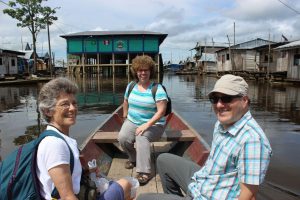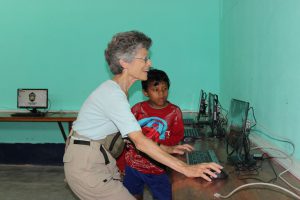After more than a decade of dedicated work in Tanzania, we turned our sights to the Peruvian Amazon this summer with a pilot expansion of our award-winning SPARC (Solar-Powered Access to Raspberry Pi Computing) program. The San Francisco Rio Itaya School in Iquitos, Peru is now home to a brand new lab equipped with 15 Raspberry Pi desktops for student use.
Peru, like Tanzania, is a fascinating country with an amazing cultural scene. A full two-thirds of the country is covered by the Amazon Rainforest. This alone would make Peru a serious destination for many travelers to explore, but it also houses additional wonders like the Andes Mountains, the Sechura Desert, Lake Titicaca, and Rainbow Mountain.
Yet all this natural beauty comes with a high price. Though this country is the 6th largest producer of gold, some areas of Peru are severely underdeveloped and unsuited for large-scale industrialization. With the Amazon River surrounding its borders and backed by the thick canopy of the Amazon rainforest, remote areas have survived conditions that almost defy description.

Belén, often called “the floating city,” is one such region. It is one of four districts in the metropolitan city of Iquitos, which is known as the largest city in the world that is accessible only by air or water.
The people of Iquitos are ever watchful of the river and all too aware of its power. “La langosta dormida es llevada al arroyo” is a popular Peruvian proverb among boatmen meaning “The sleeping lobster is carried away by the stream.” They recognize that the same river giving life to the rainforest can exact a very real human toll.
For these reasons and more, Iquitos presented unique challenges for Powering Potential. Expanding into a South American country also required expertise in Spanish, the educational setting and the culture.

San Francisco School is built two stories up on stilts because flooding is an annual event in the lower section of Belén, which is located on the floodplain of the Río Itaya. Most of its 65,00 inhabitants live in homes constructed from basic materials that are on stilts or built to float on the river. Children play and swim in contaminated water used for drinking, laundry, and waste disposal. Most people have parasites and dwellings are often swept away by floodwaters made increasingly worse by deforestation practices and the resulting erosion. The rainy season has also been problematic and longer in duration in the last two decades.
Under the leadership of Director Anita Gil Avila, San Francisco School is the pride of the neighborhood. As our team worked on the lab, the children practiced marching and singing for the national holiday celebration to be held there. A week later, another community gathering celebrated the 40th anniversary of the school. The building is used for both primary and secondary school. Younger students attend from 7:30 am to 12:30 pm and older ones in the afternoon. We watched students arriving and leaving on homemade wooden boats (as we did, also). Most wore uniforms and all carried smiles.

Dana Rensi, PPI Regional Director, Latin America led the Management Team pilot expansion. An Educational Media Specialist in Ashland, Oregon and a recipient of a Fulbright Distinguished Award in Teaching, she previously spent a year as a Fulbright Exchange Teacher in Iquitos. After receiving a grant from The Foundation for Learning Equality, she returned to the San Francisco Rio Itaya School to install our first SPARC lab on the South American continent.

PPI Management Team Members V. Ena Haines, retired Director of Information Technology at Teachers College, Columbia University and Rich Segal, Ph.D., Computer Scientist at the IBM Thomas J. Watson Research Center were also on-site to help with the installation. Joined by PPI Volunteers Joanna and Annie Segal, this dream team completed the lab with record speed while interacting with students eager to get a first glimpse of the computers.

The SPARC lab captivated students and teachers alike during its construction. No doubt it will continue to do so as the student body begins to utilize the wealth of digital content now available for use. Dana will spend two months this fall working with teachers and students, particularly using Learning Equality’s interactive Kolibri product to support one primary and one secondary grade in math. The lab also features a Pi-oneer, which is a 512GB RACHEL Pi, an AAXA P300 Projector and a portable battery pack combined for use as an audiovisual teaching tool. This kit allows teachers to use material from the virtual library in any classroom in the school.

This incredible success would not be possible if not for the generosity and compassion of readers like you. We encourage you to learn more and get involved with our efforts in the Peruvian Amazon!
To donate: Poweringpotential.org/donate